New South governor facts for kids
"New South governors" were leaders of states in the Southern United States during the second half of the 1900s. These governors were often moderate or conservative in their politics. They were known for avoiding talk about race and for wanting to improve how government worked.
A Changing South
In the early 1900s, the Southern United States had strict Jim Crow laws. These laws enforced racial segregation, meaning Black and white people were kept separate. Many Black citizens were also prevented from voting. State governments were often controlled by one political party.
Things began to change after 1954. The United States Supreme Court made a big decision in the Brown v. Board of Education case. This ruling said that separate schools for Black and white children were unfair. The civil rights movement also grew stronger, pushing for equal rights. In 1965, the Voting Rights Act was passed. This law helped many more Black citizens register to vote and take part in politics.
As a result, Black voters and moderate white voters started working together. They began to change who won elections in the South.
New Leaders Emerge
New South governors usually avoided using racial slurs or strongly supporting segregation during their campaigns. Their campaigns were more modern and used media like TV and radio. They built support from moderate white voters and Black voters.
Terry Sanford was one of the first New South governors. He was elected Governor of North Carolina in 1960. He focused on peaceful race relations, better education, and growing the economy. Carl Sanders of Georgia was elected in 1962.
In 1970, several more New South governors were elected:
- Reubin Askew in Florida
- John C. West in South Carolina
- Dale Bumpers in Arkansas
- Jimmy Carter in Georgia
Many news outlets celebrated these elections. They saw it as a sign of positive change in the South. Dale Bumpers said these elections were "a cry for new leadership in the South." When they took office, these governors promised to move past old racial issues. They tried to avoid topics that might upset white voters. Bill Waller won in Mississippi in 1971. He was followed by Cliff Finch in 1975, who was also seen as a New South leader.
By 1972, almost all Southern states had elected a governor who spoke about race in a moderate way. Even George Wallace of Alabama, who had run a campaign with strong racial messages, changed his approach after he won in 1970.
Later, another group of New South governors came into power. These included Richard Riley (South Carolina), Bob Graham (Florida), George Busbee (Georgia), David Treen (Louisiana), William F. Winter (Mississippi), Lamar Alexander (Tennessee), Chuck Robb (Virginia), David Pryor (Arkansas), Bill Clinton (Arkansas), James Holshouser (North Carolina), Jim Hunt (North Carolina), and James G. Martin (North Carolina). Many of them looked up to Terry Sanford as an example.
Some of these governors became very important in national politics. Jimmy Carter became President of the United States in 1976, and Bill Clinton became President in 1992. Most New South governors were replaced by more conservative leaders in the 1980s and 1990s.
Most New South governors were Democrats. The Democratic Party had been very strong in the South for a long time. However, a few New South governors were Republicans. James Holshouser was the first Republican governor of North Carolina in 76 years. Dave Treen was the first Republican governor of Louisiana in over 100 years.
What They Believed
New South governors were often well-educated. Sometimes, they had studied outside the South. As governors, they were active leaders who wanted to improve government. They focused on making government more efficient and honest.
They supported some new government services. However, they usually avoided big tax increases. The changes they supported were mostly in areas like education, mental health services, and prisons. Most of them wanted to invest public money in roads and other important structures. But they did not support programs that would redistribute wealth. Many of them were careful with money, meaning they were economically conservative.
These governors also avoided talking about race in a negative way. They took a moderate approach to racial issues. They did this because they wanted to attract new businesses and skilled workers to their states. They also tried to have better relationships with the national government. Earlier governors had often focused more on "states' rights" and less on working with the federal government.
List of New South Governors
Became governor because the previous governor died or resigned
| Governor | Party | State | Term | Notes | ||||
|---|---|---|---|---|---|---|---|---|
| Start | End | Length of service |
||||||
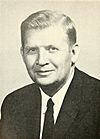 |
Terry Sanford | Democratic | North Carolina | January 5, 1961 | January 8, 1965 | 4 years, 3 days | Later served as U.S. Senator from 1986 to 1993. | |
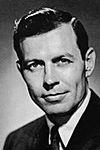 |
Carl Sanders | Democratic | Georgia | January 14, 1963 | January 10, 1967 | 3 years, 361 days | ||
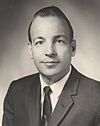 |
Albert Brewer | Democratic | Alabama | May 7, 1968 | January 18, 1971 | 2 years, 256 days | ||
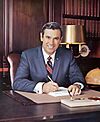 |
Reubin Askew | Democratic | Florida | January 5, 1971 | January 2, 1979 | 7 years, 362 days | ||
 |
Dale Bumpers | Democratic | Arkansas | January 12, 1971 | January 3, 1975 | 3 years, 356 days | Later served as U.S. Senator from 1975 to 1999. | |
 |
Jimmy Carter | Democratic | Georgia | January 12, 1971 | January 14, 1975 | 4 years, 2 days | Later served as President of the United States from 1977 to 1981. | |
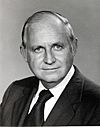 |
John C. West | Democratic | South Carolina | January 19, 1971 | January 21, 1975 | 4 years, 2 days | ||
 |
Bill Waller | Democratic | Mississippi | January 18, 1972 | January 20, 1976 | 4 years, 2 days | ||
 |
James Holshouser | Republican | North Carolina | January 5, 1973 | January 8, 1977 | 4 years, 3 days | ||
 |
David Pryor | Democratic | Arkansas | January 14, 1975 | January 3, 1979 | 3 years, 354 days | Later served as U.S. Senator from 1979 to 1997. | |
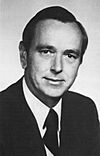 |
George Busbee | Democratic | Georgia | January 14, 1975 | January 11, 1983 | 7 years, 362 days | ||
 |
Cliff Finch | Democratic | Mississippi | January 20, 1976 | January 22, 1980 | 4 years, 2 days | ||
 |
Jim Hunt | Democratic | North Carolina | January 8, 1977 January 9, 1993 |
January 5, 1985 January 6, 2001 |
15 years, 364 days | ||
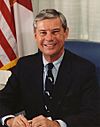 |
Bob Graham | Democratic | Florida | January 2, 1979 | January 3, 1987 | 8 years, 1 day | Later served as U.S. Senator from 1987 to 2005. | |
 |
Bill Clinton | Democratic | Arkansas | January 9, 1979 January 11, 1983 |
January 19, 1981 December 22, 1992 |
11 years, 356 days | Later served as U.S. President from 1993 to 2001. | |
 |
Richard Riley | Democratic | South Carolina | January 10, 1979 | January 14, 1987 | 8 years, 4 days | ||
 |
Lamar Alexander | Republican | Tennessee | January 20, 1979 | January 17, 1987 | 7 years, 362 days | Later served as U.S. Senator from 2003 to 2021. | |
 |
William F. Winter | Democratic | Mississippi | January 22, 1980 | January 10, 1984 | 3 years, 353 days | ||
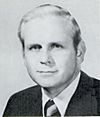 |
Dave Treen | Republican | Louisiana | March 10, 1980 | March 12, 1984 | 4 years, 2 days | ||
 |
Chuck Robb | Democratic | Virginia | January 16, 1982 | January 18, 1986 | 4 years, 2 days | Later served as U.S. Senator from 1989 to 2001. | |
 |
James G. Martin | Republican | North Carolina | January 5, 1985 | January 9, 1993 | 8 years, 4 days | ||

